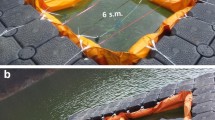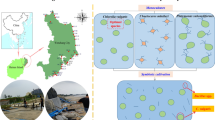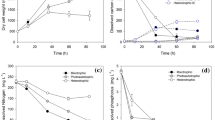Abstract
To achieve the sustainable and effective removal efficiency of nutrients in black odorous water, light source, inter-species microalgae mixed culture, and the harvesting effect were all explored. The results showed that under a LED light source, the addition of interspecific soluble algal products (SAP) promoted the growth of Haematococcus pluvialis (H. pluvialis) M1, and its maximum specific growth rate was 1.76 times that of H. pluvialis cultivated alone. That was due to the hormesis effect between the two kinds of microalgae, the SAP produced by Scenedesmus could stimulate the growth of H. pluvialis. The algae and bacteria symbiotic system with black odorous water as the medium showed excellent performance to treat nutrients, where the concentration of ammonia nitrogen (NH3-N) and total phosphorus (TP) (0.84, 0.23 mg/L) met the requirements of landscape water. The microbial diversity analysis revealed that the introduction of microalgae changed the dominant species of the bacterial community from Bacteroidota to Proteobacteria. Furthermore, timely microalgae harvesting could prevent water quality from deteriorating and was conducive to microalgae growth and resource recycling. The higher harvest efficiency (98.1%) of H. pluvialis was obtained when an inoculation size of 20% and 0.16 g/L FeCl3 were provided.
Graphical abstract







Similar content being viewed by others
Data availability
All data generated or analyzed during this study are included in this published article.
References
APHA (2005) Standard methods for the examination of water and wastewater, 21st edn. American Public Health Association, Washington D, C., USA
Aydin S, Nlü L, Arabac DN, Duru ZA (2022) Evaluating the effect of microalga Haematococcus pluvialis bioaugmentation on aerobic membrane bioreactor in terms of performance, membrane fouling and microbial community structure. Sci Total Environ 807:149908
Bai F, Shi J, Yang S, Yang Y, Wu Z (2020) Interspecific competition between Cylindrospermopsis raciborskii and Microcystis aeruginosa on different phosphorus substrates. Environ Sci Pollut R 27:42264–42275
Elvitriana ME, Delvian D, Wahyuningsih H (2021) Organic Substances reduction in palm oil mill effluent (POME) after cultivation with locally isolated microalgae. J Advanced Res Fluid Mechanics Therm Sci 80:98–105
Fallahi A, Rezvani F, Asgharnejad H, Khorshidi E, Higgins B (2021) Interactions of microalgae-bacteria consortia for nutrient removal from wastewater: a review. Chemosphere 272:129878
Hu R, Feng H, Chang H, Wei Z, Zhang C, Zhong N et al (2022) Improving reverse osmosis concentrate treatment and nutrients conversion to Chlorella vulgaris bioenergy assisted with granular activated carbon. Sci Total Environ 815:152663
Ji X, Li H, Zhang J, Saiyin H, Zheng Z (2019) The collaborative effect of Chlorella vulgaris-Bacillus licheniformis consortia on the treatment of municipal water. J Hazard Mater 365:483–493
Lelekov AS, Shiryaev AV (2020) Dynamics of the macromolecular composition of the biomass of microalgae in the morning under natural light. Model. Hydrosphere Ecol 1(5):45–52
Li B, Jing F, Wu D, Xiao B, Hu Z (2021) Simultaneous removal of nitrogen and phosphorus by a novel aerobic denitrifying phosphorus-accumulating bacterium, Pseudomonas stutzeri ADP-19. Bioresour Technol 321(1):124445
Li S, Li F, Ho SH (2022) Biohydrogen production from microalgae for environmental sustainability. Chemosphere 291:132717
Li S, Show P, Ngo H, Ho SH (2022) Algae-mediated antibiotic wastewater treatment: a critical review. Environ Sci Ecotechnol 9:100145
Liu XY, Hong Y, Zhao GP, Zhang HK, Zhai QY, Wang Q (2021) Microalgae-based swine wastewater treatment: strain screening, conditions optimization, physiological activity and biomass potential. Sci Total Environ 807(Part3):151008
López-Serna R, García D, Bolado S, Jiménez J, Lei F (2019) Photobioreactors based on microalgae-bacteria and purple phototrophic bacteria consortia: a promising technology to reduce the load of veterinary drugs from piggery wastewater. Sci Total Environ 692:259–266
Ma R, Thomas-Hall SR, Chua ET, Eltanahy E (2018) LED power efficiency of biomass, fatty acid, and carotenoid production in Nannochloropsis microalgae. Bioresour Technol 252(1):118–126
Paddock MB, Fernández-Bayo J, Vandergheynst JS (2020) The effect of the microalgae-bacteria microbiome on wastewater treatment and biomass production. Appl Microbiol Biot 104(2):893–905
Pang N, Fu X, Fernandez JSM, Chen S (2019) Multilevel heuristic LED regime for stimulating lipid and bioproducts biosynthesis in Haematococcus pluvialis under mixotrophic conditions. Bioresour Technol 288:121525
Qian T, Yang Q et al (2019) Transformation of phosphorus in sewage sludge biochar mediated by a phosphate-solubilizing microorganism. Chem Eng J 359:1573–1580
Qin L, Liu L, Wang Z, Chen W, Wei D (2019) The mixed culture of microalgae Chlorella pyrenoidosa and yeast Yarrowia lipolytica for microbial biomass production. Bioproc Biosyst Eng 42(9):1409–1419
Ranglová K, Bure M, Manoel JC, Lakatos GE, Masojídek J (2022) Efficient microalgae feed production for fish hatcheries using an annular column photobioreactor characterized by a short light path and central LED illumination. J Appl Phycol 34(1):31–41
Ray A, Nayak M, Ghosh A (2022) A review on co-culturing of microalgae: a greener strategy towards sustainable biofuels production. Sci Total Environ 802:149765
Salam KA (2019) Towards sustainable development of microalgal biosorption for treating effluents containing heavy metals. Biofuel Res J 6(2):948–961
Santos B, Conceio DDP, Corrêa DO, Passos MF, Campos MP, Adamoski D et al (2022) Changes in gene expression and biochemical composition of Haematococcus pluvialis grown under different light colors. J Appl Phycol 34:729–743
Shijian G, Pascale C (2016) Nutrient removal, microalgal biomass growth, harvesting and lipid yield in response to centrate wastewater loadings. Water Res 88(1):604–612
Singh G, Patidar SK (2018) Microalgae harvesting techniques: a review. J Environ Manage 217:499–508
Su Y, Jacobsen C (2021) Treatment of clean in place (CIP) wastewater using microalgae: nutrient upcycling and value-added byproducts production. Sci Total Environ 785:147337
Sui Y, Jiang Y, Moretti M, Vlaeminck SE (2020) Harvesting time and biomass composition affect the economics of microalgae production. J Clean Prod 259:120782
Tan XB, Yang LB, Zhang WW, Zhao XC (2020) Lipids production and nutrients recycling by microalgae mixotrophic culture in anaerobic digestate of sludge using wasted organics as carbon source. Bioresour Technol 297:122379
Tawan C, Yusuf C (2016) Harvesting microalgae by flocculation–sedimentation. Algal Res 13:271–283
Vishnu PM, Ramesh K (2021) Optimization of process parameters of the growth of Chlorella vulgaris for the production of biodiesel feedstock (microbial lipid) using sago wastewater as substrate. Biomass Conv. Bioref. https://doi.org/10.1007/s13399-021-01401-4
Wang X, Song W, Li N, Lu J, Niu X, Ma Y, Ding J, Wang M (2020) Ultraviolet-B radiation of Haematococcus pluvialis for enhanced biological contact oxidation pretreatment of black odorous water in the symbiotic system of algae and bacteria. Biochem Eng J 157:107553
Wang X, Ding S, Song W, Li H, Ding J (2021) A collaborative effect of algae-bacteria symbiotic and biological activated carbon system on black odorous water pretreated by UV photolysis. Biochem Eng J 169:107983
Wu J, Liu J, Lin L, Zhang C, Li A, Zhu Y, Zhang Y (2015) Evaluation of several flocculants for flocculating microalgae. Bioresour Technol 197:495–501
Zareei M, Yoozbashizadeh H, Hosseini HM (2019) The effect of pH and ionic strength on the transport of alumina nanofluids in water-saturated porous media. J Therm Anal Calorim 137:1169–1179
Zhang H, Gong W, Bai L, Chen R, Zeng W, Yan Z, Li G, Liang H (2020) Aeration-induced CO2 stripping, instead of high dissolved oxygen, have a negative impact on algae–bacteria symbiosis (ABS) system stability and wastewater treatment efficiency. Chem Eng J 382:122957
Zhao XC, Tan XB, Yang LB, Liao JY, Li XY (2019) Cultivation of Chlorella pyrenoidosa in anaerobic wastewater: the coupled effects of ammonium, temperature and pH conditions on lipids compositions. Bioresour Technol 284:90–97
Zhuang LL, Wu YH, Shi XJ, Zhang TY, Hu HY (2015) Using ozonation to eliminate the inhibition of soluble algal products (SAP) of Scenedesmus sp. LX1 on its growth in microalgal cultivation for biomass/bioenergy production. Water Sci Tech-W Sup 15(5):1034–1039
Zhuang LL, Yang T, Zhang BY, Wu YH, Hu HY (2019) The growth model and its application for microalgae cultured in a suspended-solid phase photobioreactor (ssPBR) for economical biomass and bioenergy production. Algal Res 39:101463
Zou X, Li Y, Xu K, Wen H, Shen Z, Ren X (2018) Microalgae harvesting by buoy-bead flotation process using Bioflocculant as alternative to chemical flocculant. Algal Res 32:233–240
Funding
This work was supported by the Natural Science Foundation of Shandong Province, China (Grant No. ZR2020MB123) & Zibo City Integration Development Project (Grant No. 2019ZBXC392). The authors also wish to express their thanks to Zibo Jinxuan Resources and Environmental Technology Development Co. Ltd. for their sincere help during this work.
Author information
Authors and Affiliations
Contributions
All authors contributed to the study conception and design. Conceptualization, software, and writing—original draft preparation were performed by Xiaoyan Wang. Methodology and investigation were performed by Shaoxuan Ding. Validation was performed by Mengying Wang and Xiaowei Ma. Data curation, formal analysis, and investigation were performed by Huawei Li, Yonghui Zhang, and Wanchao Song, respectively. Supervision and funding acquisition were performed by Jincheng Ding. Writing—reviewing and editing, project administration, and funding acquisition were performed by Jie Lu. The first draft of the manuscript was written by Xiaoyan Wang and all authors commented on previous versions of the manuscript. All authors read and approved the final manuscript.
Corresponding author
Ethics declarations
Ethics approval
Not applicable.
Consent to participate
Not applicable.
Consent for publication
Not applicable.
Competing interests
The authors declare no competing interests.
Additional information
Responsible Editor: Diane Purchase
Publisher's note
Springer Nature remains neutral with regard to jurisdictional claims in published maps and institutional affiliations.
Supplementary Information
Below is the link to the electronic supplementary material.
Rights and permissions
About this article
Cite this article
Wang, X., Ding, S., Wang, M. et al. Effects of light source and inter-species mixed culture on the growth of microalgae and bacteria for nutrient recycling and microalgae harvesting using black odorous water as the medium. Environ Sci Pollut Res 29, 78542–78554 (2022). https://doi.org/10.1007/s11356-022-21293-9
Received:
Accepted:
Published:
Issue Date:
DOI: https://doi.org/10.1007/s11356-022-21293-9




